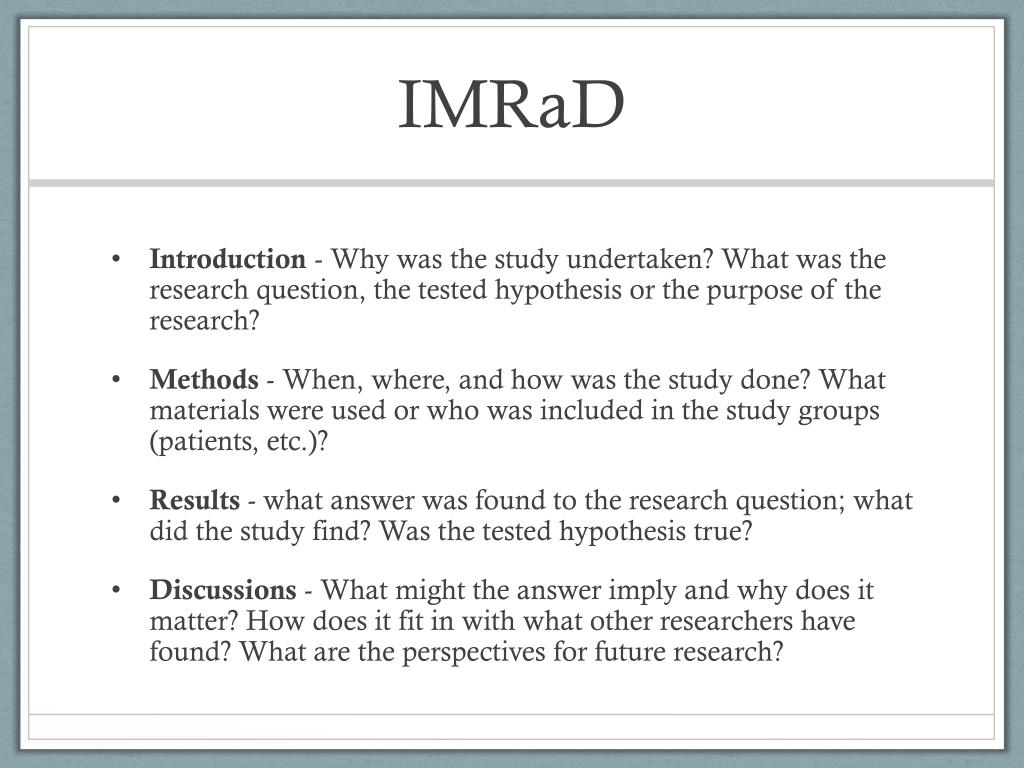
Scientific Writing: IMRAD Format A common scientific writing format is IMRAD, which stands for Introduction, Methods, Results, And Discussion. This type of scientific writing is useful for educating and recording knowledge about research processes as well as findings. While this handout offers What is an IMRaD report? 1. Refer to your table or figure and state the main trend Table 3 shows that Spam Filter A correctly filtered more junk 2. Support the trend with data Filter A correctly filtered. The average difference is. 3. (If needed) Note any additional, secondary trends and · Typically, research and scientific findings are given to the public as a research paper in the form of the IMRaD structure. To understand the IMRaD structure it
The Writing Center | Writing a Scientific Research Report (IMRaD) | Guides
We use cookies and similar technologies to improve your website experience and help us understand how you use our website. By continuing to use this website, you consent to the usage of cookies, imrad in research.
Learn more about our Privacy Statement and Cookie Policy. This format is often used for lab reports as well as for reporting any planned, systematic research in the social sciences, natural sciences, or imrad in research and computer sciences. The introduction explains why this research is important or necessary or important. Begin by describing the problem or situation that motivates the research.
Finally, explain how the present research is a solution to that problem imrad in research gap. If the study has hypotheses, they are presented at the end of the introduction.
The methods section tells readers how you conducted your study. It includes information about your population, sample, imrad in research, methods, and equipment. Methods sections typically use subheadings; they are written in past tense, and they use a lot of passive voice. This is typically the least read section of an IMRaD report. In this section, you present your findings, imrad in research. Typically, the Results section contains only the findings, not any explanation of or commentary on the findings see below.
Results sections are usually written in the past tense. Make sure all tables and figures are labeled and numbered separately. Captions go above tables and beneath figures. In this section, you summarize your main findings, comment on those findings see belowand connect them to other research. You also discuss limitations of your study, and use these limitations as reasons to suggest additional, future research.
The abstract for the report comes at the beginning of the paper, but you should write it after you have drafted the full report. See our handout on Writing Abstracts. Reporting versus Commenting on your Findings In the Results section, imrad in research, you simply report your findings.
In the Discussion section, you comment on them. Agree Decline Non-Essential Cookies. About Mission Statement The Staff The Tutors Hours and Locations Tutoring Video Tutoring Online Tutoring ESOL Writing Support Support for Writers with Disabilities Policies and Restrictions Make an Appointment Apply to Become a Tutor Workshops Upcoming Workshops Virtual Class Workshops Virtual Imrad in research Meet the Tutors Writing Resources Writing Center Quick Guides Helpful Links Video Resources For Graduate Students Graduate Writing Consultations Thesis and Dissertation Consultations Weekly Write-Ins ESOL Graduate Peer Writing Groups Setting Up Your Own Writing Group Writing Resources for Graduate Students For Faculty About Our Tutoring Promote Us to Your Students Virtual Roadshows Virtual Class Workshops Recommend Tutors.
Hours and Locations. Writing a Scientific Research Report IMRaD What is an IMRaD report? Introduction — Make a case for your research The introduction explains why this research is important or necessary or important. Methods — What did you do?
Results — What did you find? Imrad in research — What does it mean? Abstract — Summarize the entire study The abstract for the report comes at the beginning of the paper, but you should write it after you have drafted the full report.
Report Imrad in research section. Refer to your table or figure and state the main trend Table 3 shows that Spam Filter A correctly filtered more junk emails than Filter B 2. Support the trend with data Filter A correctly filtered The average difference is If needed Note any additional, secondary trends and support them with data In addition Figure 1 also shows If needed Note any exceptions to your main trends or unexpected outcomes.
Comment Discussion section. If needed Provide an explanation A feasible explanation is This trend can be explained by In contrast, Y found If needed Evaluate whether the findings support or contradict a hypothesis 4. State the bottom line: what does the data mean? These findings overall suggest These data indicate The Abstract does not provide a clear statement of the main findings.
The Introduction does not communicate clearly why the research is important. The Methods section is not detailed enough or is disorganized. The Results section provides comments and explanations instead of simply reporting results, imrad in research.
IMRaD STRUCTURE / RESEARCH PAPER WRITING / TAGALOG DISCUSSION
, time: 7:03The IMRAD Research Paper Format | Academy of Social Sciences and Humanities

While there are nuances and adjustments that would be made to the following document types, the IMRaD format is the foundational structure many research-driven documents: Grants Proposals Recommendation reports Plans (such as an integrated marketing plan or project management plan) · IMRAD (Introduction, Methods, Research [and] Discussion) is a mnemonic for a common format used for academic [‘scientific’] research papers. While used primarily in the hard sciences, like physics and biology, it is also widely used in the social and behavioral sciences · Typically, research and scientific findings are given to the public as a research paper in the form of the IMRaD structure. To understand the IMRaD structure it


No comments:
Post a Comment